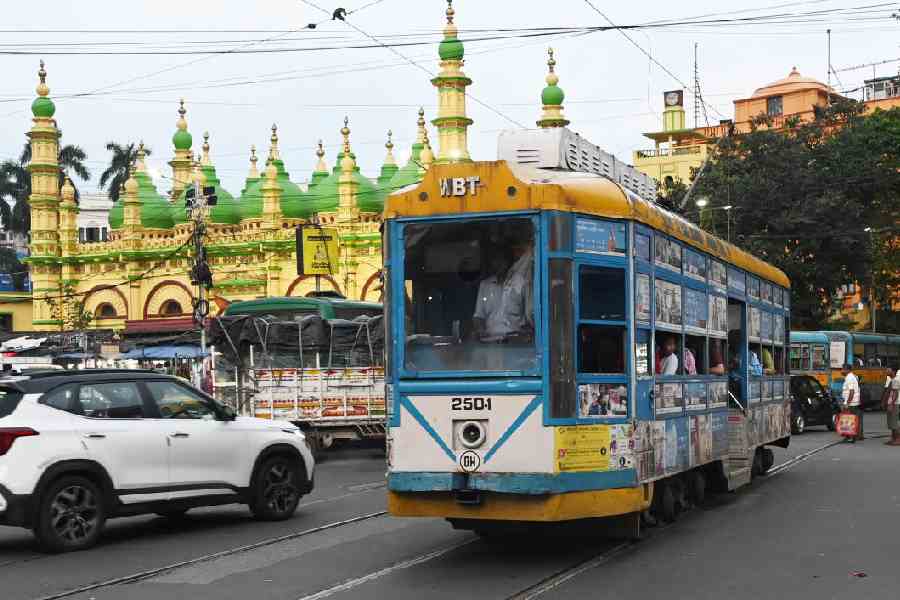The tram is not a thing of the past despite a concerted effort to create such an impression, supporters of the iconic Calcutta transport said on Friday.
The state government will run trams only on a stretch between Esplanade and Maidan and do away with the rest, transport minister Snehasis Chakraborty said on Monday.
The transport department is drawing up a report that will be submitted to Calcutta High Court, which is hearing a batch of petitions on the matter. On Tuesday, Calcutta’s mayor Firhad Hakim confirmed that the government wanted to make trams a showpiece.
“The court had asked the state to find ways to preserve heritage trams. The state government will submit a report in the court. Any decision is for the court to make. We have full faith in the judiciary. The court has in the past said that trams are an integral part of the heritage of Calcutta,” said Debashis Bhattacharyya, founder of the Calcutta Tram Users Association (CTUA), a group advocating a wider tram network.
“There is a concerted effort to create an impression that trams are a thing of the past. People are writing obituaries to trams. This is not the case. The journey is far from over,” Bhattacharyya said.
Calcutta’s trams may have lost their popularity as a means of transport over the decades but any pictorial depiction of the city in popular culture still has a tram alongside the Howrah Bridge and the Victoria Memorial.
From 25 tram routes in 2015, the service is now available on just two routes a year after Calcutta celebrated 150 years of tram service in 2023.
The CTUA and a host of other groups have called for a demonstration and rally to save trams on October 5. The rallyists will assemble at College Square at 4pm and march till Shyambazar, where the tram depot is still a landmark.
At a news conference on Friday, members of the CTUA and other tram lovers’ groups countered the arguments that the government has put forward many times as a reason for wanting to stop trams on most routes.
Most of the “flawed arguments” have been put forward by the police in a report submitted to the state government, said tram lovers.
Traffic congestion
Supporters of trams said there was no study to show that trams slowed down traffic.
“Trams actually help in decongesting the road. A tram carries 120 to 130 people. This means a reduction in space required per commuter. A tram is taking care of the capacity of 40 to 50 cars,” said Bhattacharyya.
He said the unauthorised parking of cars on tram tracks was to blame for the slow movement of trams.
The steep rise in the number of cars is causing more problems on the road, said tram supporters.
“Between 2011 and 2022, the number of registered cars in the Kolkata metropolitan area has gone up from 21 lakh to 51 lakh,” said Mahadeb Shi, secretary of the CTUA and a member of the expert committee constituted by the high court for the preservation of the “heritage transport”.
He said he was quoting from “reports in the public domain”.
Accident-prone
Members of the CTUA cited a “police reply” to an RTI query to claim that between 2012 and 2022, there has been only one fatal accident on tram tracks in Calcutta.
“There are no statistics to suggest trams pose road safety risks. All the government needs to do is create dedicated boarding and deboarding zones,” said a member.
Mounting losses
Trams need minimal operational expenditure and have a service life that is much longer than that of buses, said Bhattacharyya.
“Trams have made a comeback in many cities all over the world. It has been possible because trams are economically viable,” he said.
The government needs to run more trams at shorter intervals. The timings should be displayed. That will bring back confidence in commuters and ridership will go up,” he said.
Police opposition
Senior officials in the transport department said an earlier attempt to revive some of the routes covering parts of the city’s north had to be shelved following opposition from the police.
“Senior officers from Lalbazar had argued that movement of trams on some stretches like Rabindra Sarani and Lalbazar Street impede traffic movement because the tram cars would move against the normal flow,” said a senior official.
There are other operational challenges. In stretches where the overhead wires have to be restored, the power supply needs to be kept uninterrupted 24X7.
“Once a wire is bought, restored and kept live, power can’t be switched off. Cables get stolen,” the official said.











